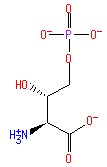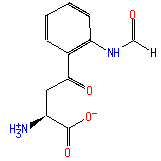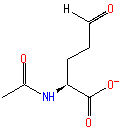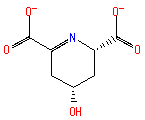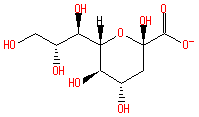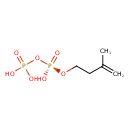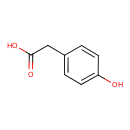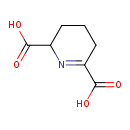
Search Results for compounds
Searching compounds for
returned 4373 results.
Displaying compounds 3191 - 3200 of
4373 in total
4-phospho-hydroxy-L-threonine (PAMDB110159)
IUPAC:
Not Available
CAS: Not Available
Description: Not Available
N-acetyl-L-glutamate 5-semialdehyde (PAMDB110161)
IUPAC:
Not Available
CAS: Not Available
Description: Not Available
(2S,4S)-4-hydroxy-2,3,4,5-tetrahydrodipicolinate (PAMDB110162)
IUPAC:
Not Available
CAS: Not Available
Description: Not Available
2-keto-3-deoxy-D-glycero-D-galacto-nononate (PAMDB110164)
IUPAC:
Not Available
CAS: Not Available
Description: Not Available
isopentenyl diphosphate (PAMDB110165)
IUPAC:
3-methylbut-3-en-1-yl diphosphate
CAS: 358-71-4
Description: Trianion of isopentenyl diphosphate arising from deprotonation of the three OH groups of the diphosphate.
4-hydroxyphenylacetate (PAMDB110166)
IUPAC:
(4-hydroxyphenyl)acetate
CAS: 156-38-7
Description: A monocarboxylic acid anion that is obtained by removal of a proton from the carboxylic acid group of 4-hydroxyphenylacetic acid.
(S)-2,3,4,5-tetrahydrodipicolinate (PAMDB110167)
IUPAC:
(2S)-2,3,4,5-tetrahydropyridine-2,6-dicarboxylate
CAS: 2353-17-5
Description: Tetrahydrodipicolinate, converted from L-aspartate, is an important intermediate in lysine biosynthesis pathway. Several pathways are now recognized in bacteria, most algae, fungi and higher plants for the biosynthesis of lysine. They are divided into two groups - the diaminopimelate (DAP) pathways, and the α-aminoadipate (AAA) pathways. In the pathways that belong to the DAP group, lysine is produced from aspartate (along with methionine, threonine and isoleucine). All of these pathways share the upper segments, which include the four steps required for conversion of L-aspartate to tetrahydrodipicolinate. They also share the last step, which is the conversion of the intermediate meso-diaminopimelate (D,L-DAP, or meso-DAP) to lysine. However, these pathways differ in the routes leading from tetrahydrodipicolinate to meso-diaminopimelate. The four variations include: (I) the succinylase variant, which involves succinylated intermediates. In this route tetrahydrodipicolinate is coverted to meso-diaminopimelate in four enzymatic steps; (II) the acetylase variant, which involves acetylated intermediates. This route also involves four enzymatic steps for the conversion of tetrahydrodipicolinate to meso-diaminopimelate; (III) the dehydrogenase variant, in which tetrahydrodipicolinate is converted to meso-diaminopimelate in a single enzymatic step; (IV) the diaminopimelate-aminotransferase variant, in which tetrahydrodipicolinate is converted to meso-diaminopimelate in two steps. In addition to lysine, the pathways in this group also produce meso-DAP, which is an important metabolite on its own.
3-dehydroquinate (PAMDB110168)
IUPAC:
rel-(1R,3R,4S)-1,3,4-trihydroxy-5-oxocyclohexanecarboxylate
CAS: Not Available
Description: A hydroxy monocarboxylic acid anion that is obtained by removal of a proton from the carboxylic acid group of 3-dehydroquinic acid.
